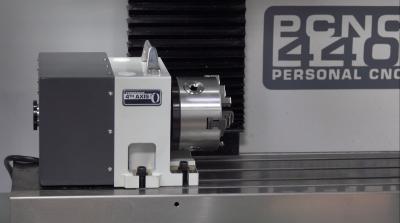
Tormach Inc., the industry’s leading supplier of affordable and compact CNC machines, has announced it is now offering the microARC 4, a device that allows high-precision 4th axis machining in a compact footprint. The microARC 4 works with all Tormach machines, from the PCNC 440 Mill to the 1100 M/MX Mill. Like all Tormach products, the microARC 4 is available at a very attractive price point – just $2,299, which is significantly less than other brands.
microARC 4 reduces both operator workload and cycle times with a high-quality, low-maintenance harmonic drive. The drive provides extremely precise motion control, coupled with much higher rapid speeds than a worm-drive unit. Key features of the microARC 4 include:
- Near-zero backlash levels because of the harmonic drive system; compared to a similar size worm-drive 4th axis unit, the microARC 4 achieves anywhere from a 400%-600% reduction in backlash;
- No maintenance required, providing a much lower cost of ownership than an oil-filled worm drive unit, which requires periodic oil changes and top-ups;
- Smoother start and stop motion due to a crossed-roller bearing instead of a large oil-film hydrodynamic bearing that is common on most other 4th axis units, which require a transition from static to dynamic friction;
- 19mm center bore pass-through for long bar stock; stock can be passed all the way through the chuck and out the back of the 4th axis – no need to cut stock into small pieces when doing a production run of many parts;
- The microARC 4’s motor is mounted directly in-line with the axis of rotation instead of off to the side, providing an extremely compact footprint;
- Lightweight and strong aluminum body allows for installation into the machine without a hoist or team lift.
“The microARC 4 is a very versatile, useful addition for machinists looking to add a 4th axis to their Tormach CNC Mills,” said Peter Den Hartog, Machine Design Engineer at Tormach. “It not only enhances machining capabilities, but it provides much better performance than traditional 4th axis devices.”
microARC 4 is available for purchase on the Tormach website.
Contact Details
Related Glossary Terms
- backlash
backlash
Reaction in dynamic motion systems where potential energy that was created while the object was in motion is released when the object stops. Release of this potential energy or inertia causes the device to quickly snap backward relative to the last direction of motion. Backlash can cause a system’s final resting position to be different from what was intended and from where the control system intended to stop the device.
- chuck
chuck
Workholding device that affixes to a mill, lathe or drill-press spindle. It holds a tool or workpiece by one end, allowing it to be rotated. May also be fitted to the machine table to hold a workpiece. Two or more adjustable jaws actually hold the tool or part. May be actuated manually, pneumatically, hydraulically or electrically. See collet.
- computer numerical control ( CNC)
computer numerical control ( CNC)
Microprocessor-based controller dedicated to a machine tool that permits the creation or modification of parts. Programmed numerical control activates the machine’s servos and spindle drives and controls the various machining operations. See DNC, direct numerical control; NC, numerical control.
- milling machine ( mill)
milling machine ( mill)
Runs endmills and arbor-mounted milling cutters. Features include a head with a spindle that drives the cutters; a column, knee and table that provide motion in the three Cartesian axes; and a base that supports the components and houses the cutting-fluid pump and reservoir. The work is mounted on the table and fed into the rotating cutter or endmill to accomplish the milling steps; vertical milling machines also feed endmills into the work by means of a spindle-mounted quill. Models range from small manual machines to big bed-type and duplex mills. All take one of three basic forms: vertical, horizontal or convertible horizontal/vertical. Vertical machines may be knee-type (the table is mounted on a knee that can be elevated) or bed-type (the table is securely supported and only moves horizontally). In general, horizontal machines are bigger and more powerful, while vertical machines are lighter but more versatile and easier to set up and operate.
- payload ( workload)
payload ( workload)
Maximum load that the robot can handle safely.
